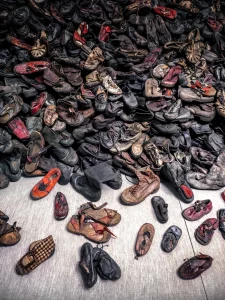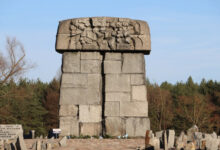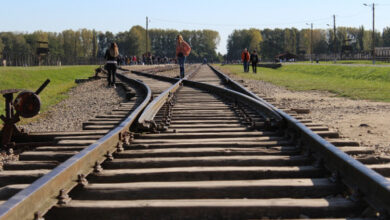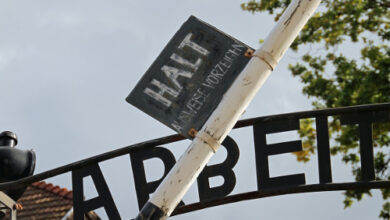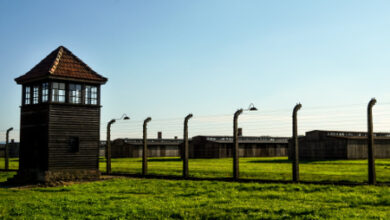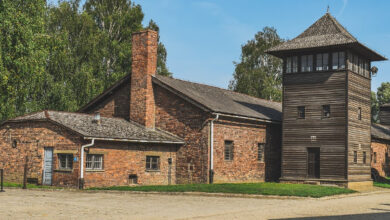During the Second World War the humanity faced many acts of brutality and violence. Probably the worst and the shockiest thing that happened that time was the Holocaust. One of the places where it took place was the death (extermination) camp Auschwitz – the largest and the deadliest place of mass murders on Jews, Gypsies, Poles and other nationalities.
Today we can see what is left after that – buildings, wires and some personal stuff of the previous victims, e.g. hair – and toothbrushes, glasses, bags and suitcases, shoes… Auschwitz shoes are one of the evidences of what the Nazis have done to over 1,1 mil of people.
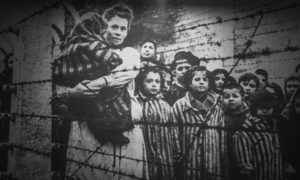
Table of Contents:
The Museum has launched a two-year project for the conservation of children’s shoes
The Auschwitz-Birkenau State Museum has commenced a poignant two-year project to conserve 8,000 shoes that once belonged to children before they were tragically killed at the Nazi German death camp.
This emotional endeavour is taking place in a modern conservation laboratory on the grounds of the former Auschwitz camp, where conservationists meticulously work with specialised tools to preserve the small shoes, removing any rust and decay that has accumulated over the years.
Each carefully conserved shoe serves as a powerful reminder of the horrifying experiences endured by countless children and their families during the Holocaust.
As the conservation team delves deeper into this process, they have encountered heartbreaking discoveries within the footwear, further emphasising the horrors that took place during this dark time in history.
Through this painstaking and emotional task, the museum aims to ensure that the memory of the victims is preserved and honoured, allowing future generations to learn from the tragedies that occurred at Auschwitz-Birkenau and serve as a potent reminder of the importance of tolerance, empathy, and understanding in our increasingly interconnected world.
Auschwitz Shoes: A Symbol of Tragedy
Victims and Their Possessions
Among the countless personal items found at Auschwitz were shoes, which serve as a poignant representation of the lives lost during this tragic time.
These shoes, along with other personal belongings, were taken from the millions of Jews and other targeted groups who were forcibly transported to the death camp.
The collection process at Auschwitz involved separating the victims from their possessions, which were then sorted and stored for various purposes.
Shoes were a valuable commodity during the war, and the Nazis exploited this resource. As these shoes were systematically confiscated and sorted, they became a lasting testament to the scale of the Holocaust and the human lives it claimed.
Children’s Shoes: A Harrowing Testament
Perhaps the most heart-wrenching aspect of the Auschwitz shoe collection is the 8,000 children’s shoes found among the possessions.
These shoes, often worn and damaged, belonged to young victims who were murdered at the Nazi German death camp. Evaluating the number of shoes recovered gives a small insight into the tragedy, as it becomes evident that many of these children never had the chance to grow up and lead full lives.
A two-year effort to preserve these children’s shoes began in May 2023 at the Auschwitz-Birkenau State Museum, bringing attention to this poignant symbol of the Holocaust. The painstaking work of conserving these shoes not only ensures their physical preservation but also serves as a vital reminder of the atrocities committed during this dark period in human history.
In both the shoes of adults and the fragile footwear of children, the Holocaust’s chilling reality is presented. These simple yet evocative items connect us to the past and tell a heart-wrenching story of a tragedy that must never be forgotten.
Conservation and Exhibition
Auschwitz-Birkenau State Museum
The Auschwitz-Birkenau State Museum, located on the grounds of the former Auschwitz concentration camp, is a significant site for preserving the memory of the victims and educating visitors about the Holocaust.
The museum houses various exhibitions displaying artefacts related to the history of the camp, eg room of hairs or shoes room.
Preserving the Shoes
In recent years, the museum has initiated a project aimed at conserving and preserving these thousands of shoes as a way to honour the memory of their owners. The conservation process involves careful examination of each shoe, with conservators removing rust from metal eyelets and performing other restoration work as needed.
This project not only conserves the physical condition of the shoes but also helps uncover the individual stories of those who wore them.
For example, during the conservation process, an inscription was discovered inside one of the shoes, revealing the name of a six-year-old boy, Amos Steinberg. This discovery enabled researchers to trace his story, revealing that he was sent to Auschwitz from the Theresienstadt Ghetto near Prague on October 4th, 1944.
Such findings offer a powerful connection to the individual lives impacted by the Holocaust, adding depth to the overall narrative presented within the museum.
Check also:
Personal Stories and Testimonies
Handwritten Inscriptions on Shoes
Among the thousands of shoes preserved at the Auschwitz museum, some carry handwritten inscriptions that offer a glimpse into the lives of their owners. These inscriptions serve as a testament to the resilience and hope that existed even in the face of unimaginable terror.
One remarkable example includes the shoes of Věra Vohryzková, a young girl from the Theresienstadt ghetto. Věra etched a message of courage and hope onto her shoes, which stands as an enduring reminder of the strength the human spirit possesses even amidst the horrors of the Holocaust.
Survivor Accounts
Survivors of Auschwitz have bravely shared their experiences, providing invaluable insights into the daily lives and struggles of those forcibly brought to the concentration camp.
One such testimony comes from Amos Steinberg, who had been deported to Auschwitz after a period spent at the Theresienstadt ghetto. His account highlights not only the unspeakable horrors he endured but also the tenacity and courage needed to survive in such an environment.
Many other survivors have come forward to share their stories as well, through written testimonies, public programs, and oral histories.
These survivor reflections contribute to our understanding of the Holocaust and allow us to learn from their experiences, ensuring that the memory of those who suffered remains alive in our collective consciousness.
Impact of Mass Tourism on Auschwitz
Mass tourism at Auschwitz poses a threat to the preservation of this site, which stands as a dark reminder of human tragedy from a bygone era.
As the years pass, the site faces issues related to the conservation of its artefacts, including the thousands of shoes from children who were victims of the Holocaust.
Protecting the Site and Its Artefacts
Efforts are being made to conserve the artefacts that provide an emotional testimony of the victims.
Additionally, pressure increases on the museum’s staff to protect artefacts like the hair sheared from victims, considered a sacred human remain, from being photographed or damaged by the influx of tourists.
While mass tourism adds to the challenges in safeguarding Auschwitz, the importance of keeping the memory of the Holocaust alive cannot be denied. However, site conservation and visitor management must strike a balance, ensuring that future generations can continue to bear witness to this harrowing chapter in history.
Frequently Asked Questions
What are Auschwitz shoes?
Auschwitz shoes refer to the footwear that belonged to prisoners of the Auschwitz-Birkenau concentration camp during the Holocaust. These shoes were worn by victims, including children, before they were sent to gas chambers and killed by the Nazis.
Why were they collected?
Shoes, along with other belongings of the Auschwitz-Birkenau victims, were collected by the Nazis as part of their systematic extermination process. The Nazis often reused, recycled or sold personal items taken from the prisoners, contributing to the war economy.
What do they symbolise?
Auschwitz shoes serve as a powerful symbol of the immense tragedy that befell the victims of the Holocaust. The shoes, especially those belonging to children, evoke the immeasurable loss of life, innocence, and human potential that the Holocaust entailed.
Where are they displayed?
Many of the Auschwitz shoes are displayed at the Auschwitz-Birkenau State Museum in Poland, housed in large glass cases. The museum is situated on the grounds of the former concentration camp, preserving the memory of those who suffered and died there.
How were they preserved?
Conservation efforts to preserve the Auschwitz shoes have been undertaken by teams at the museum. In modern conservation laboratories, experienced staff meticulously work to remove rust, decay, and other elements that threaten the integrity of the shoes. These efforts help to ensure that the memory of the Holocaust endures and that visitors to the museum can bear witness to the tragic history that these shoes represent.
How many shoes were found in Auschwitz?
During Holocaust in Auschwitz died around 1,1 millions of people. Today we can visit the gardens of remembrance and see the Auschwitz shoes which are left. How many pairs of shoes were found? It’s really hard to count it all exactly, but the counts say it’s around 110 000 pairs of shoes.
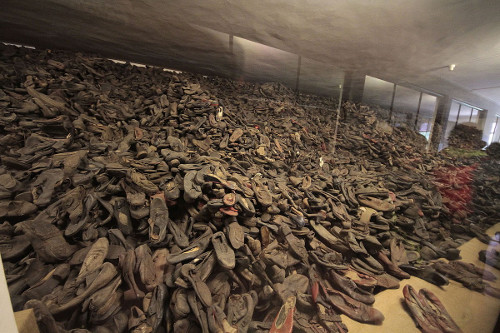
Where can you see the Auschwitz shoes?
All the footwear of the former prisoners which is left you can find at the Auschwitz – Birkenau Museum. There is a special room called shoe room. You can see there a huge pile of the victims’ shoes behind the panes. Even the view of things like these – normal everyday stuff which everybody uses – can trigger deep emotions of grief or even anger.
Therefore you should not take children under 14 to this place. All the personal belongings taken from prisoners are being stored up in Auschwitz I in the block number 5.
